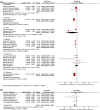Impact of sugar-sweetened beverage taxes on purchases and dietary intake: Systematic review and meta-analysis
- PMID: 31218808
- PMCID: PMC9285619
- DOI: 10.1111/obr.12868
Impact of sugar-sweetened beverage taxes on purchases and dietary intake: Systematic review and meta-analysis
Abstract
The aim was to conduct a systematic review of real-world sugar-sweetened beverage (SSB) tax evaluations and examine the overall impact on beverage purchases and dietary intake by meta-analysis. Medline, EconLit, Google Scholar, and Scopus databases were searched up to June 2018. SSB tax evaluations from any formal jurisdiction from cities to national governments were eligible if there was a comparison between pre-post tax (n = 11) or taxed and untaxed jurisdiction(s) (n = 6). The consumption outcome comprised sales, purchasing, and intake (reported by volume, energy, or frequency). Taxed and untaxed beverage consumption outcomes were examined separately by meta-analysis with adjustment for the size of each tax. The study was registered at PROSPERO (CRD42018100620). The equivalent of a 10% SSB tax was associated with an average decline in beverage purchases and dietary intake of 10.0% (95% CI: -5.0% to -14.7%, n = 17 studies, 6 jurisdictions) with considerable heterogeneity between results (I2 = 97%).The equivalent of a 10% SSB tax was also associated with a nonsignificant 1.9% increase in total untaxed beverage consumption (eg, water) (95% CI: -2.1% to 6.1%, n = 6 studies, 4 jurisdictions). Based on real-world evaluations, SSB taxes introduced in jurisdictions around the world appear to have been effective in reducing SSB purchases and dietary intake.
Keywords: evaluation; excise; meta-analysis; natural experiment; soft drinks; tax.
© 2019 The Authors Obesity Reviews published by John Wiley & Sons Ltd on behalf of World Obesity Federation.
Conflict of interest statement
All authors have completed the ICMJE uniform disclosure form at
Figures




References
-
- Malik VS, Willett WC, Hu FB. Global obesity: trends, risk factors and policy implications. Nat Rev Endocrinol. 2013;9:13‐27. - PubMed
-
- Imamura F, O'Connor L, Ye Z, et al. Consumption of sugar sweetened beverages, artificially sweetened beverages, and fruit juice and incidence of type 2 diabetes: systematic review, meta‐analysis, and estimation of population attributable fraction. BMJ. 2015;351:h3576. 10.1136/bmj.h3576 - DOI - PMC - PubMed
Publication types
MeSH terms
LinkOut - more resources
Full Text Sources
Medical

